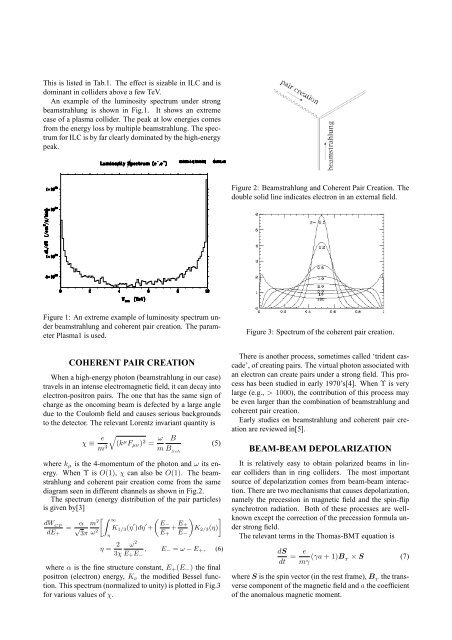Proceedings of International Conference on Physics in ... - KEK
Proceedings of International Conference on Physics in ... - KEK
Proceedings of International Conference on Physics in ... - KEK
You also want an ePaper? Increase the reach of your titles
YUMPU automatically turns print PDFs into web optimized ePapers that Google loves.
This is listed <strong>in</strong> Tab.1. The effect is sizable <strong>in</strong> ILC and is<br />
dom<strong>in</strong>ant <strong>in</strong> colliders above a few TeV.<br />
An example <str<strong>on</strong>g>of</str<strong>on</strong>g> the lum<strong>in</strong>osity spectrum under str<strong>on</strong>g<br />
beamstrahlung is shown <strong>in</strong> Fig.1. It shows an extreme<br />
case <str<strong>on</strong>g>of</str<strong>on</strong>g> a plasma collider. The peak at low energies comes<br />
from the energy loss by multiple beamstrahlung. The spectrum<br />
for ILC is by far clearly dom<strong>in</strong>ated by the high-energy<br />
peak.<br />
Figure 1: An extreme example <str<strong>on</strong>g>of</str<strong>on</strong>g> lum<strong>in</strong>osity spectrum under<br />
beamstrahlung and coherent pair creati<strong>on</strong>. The parameter<br />
Plasma1 is used.<br />
COHERENT PAIR CREATION<br />
When a high-energy phot<strong>on</strong> (beamstrahlung <strong>in</strong> our case)<br />
travels <strong>in</strong> an <strong>in</strong>tense electromagnetic field, it can decay <strong>in</strong>to<br />
electr<strong>on</strong>-positr<strong>on</strong> pairs. The <strong>on</strong>e that has the same sign <str<strong>on</strong>g>of</str<strong>on</strong>g><br />
charge as the <strong>on</strong>com<strong>in</strong>g beam is defected by a large angle<br />
due to the Coulomb field and causes serious backgrounds<br />
to the detector. The relevant Lorentz <strong>in</strong>variant quantity is<br />
χ ≡ e<br />
m3 <br />
(k µ Fµν) 2 = ω<br />
m<br />
B<br />
B Sch<br />
where kµ is the 4-momentum <str<strong>on</strong>g>of</str<strong>on</strong>g> the phot<strong>on</strong> and ω its energy.<br />
When Υ is O(1), χ can also be O(1). The beamstrahlung<br />
and coherent pair creati<strong>on</strong> come from the same<br />
diagram seen <strong>in</strong> different channels as shown <strong>in</strong> Fig.2.<br />
The spectrum (energy distributi<strong>on</strong> <str<strong>on</strong>g>of</str<strong>on</strong>g> the pair particles)<br />
is given by[3]<br />
dW CP<br />
dE+<br />
= α m<br />
√<br />
3π<br />
2<br />
ω2 ∞<br />
η<br />
K1/3(η ′ )dη ′ <br />
E−<br />
+<br />
η = 2<br />
3χ<br />
ω 2<br />
E+E−<br />
+<br />
E+<br />
E+<br />
E−<br />
<br />
(5)<br />
K2/3(η)<br />
<br />
, E− = ω − E+, (6)<br />
where α is the f<strong>in</strong>e structure c<strong>on</strong>stant, E+(E−) the f<strong>in</strong>al<br />
positr<strong>on</strong> (electr<strong>on</strong>) energy, Kν the modified Bessel functi<strong>on</strong>.<br />
This spectrum (normalized to unity) is plotted <strong>in</strong> Fig.3<br />
for various values <str<strong>on</strong>g>of</str<strong>on</strong>g> χ.<br />
Figure 2: Beamstrahlung and Coherent Pair Creati<strong>on</strong>. The<br />
double solid l<strong>in</strong>e <strong>in</strong>dicates electr<strong>on</strong> <strong>in</strong> an external field.<br />
Figure 3: Spectrum <str<strong>on</strong>g>of</str<strong>on</strong>g> the coherent pair creati<strong>on</strong>.<br />
There is another process, sometimes called ‘trident cascade’,<br />
<str<strong>on</strong>g>of</str<strong>on</strong>g> creat<strong>in</strong>g pairs. The virtual phot<strong>on</strong> associated with<br />
an electr<strong>on</strong> can create pairs under a str<strong>on</strong>g field. This process<br />
has been studied <strong>in</strong> early 1970’s[4]. When Υ is very<br />
large (e.g., > 1000), the c<strong>on</strong>tributi<strong>on</strong> <str<strong>on</strong>g>of</str<strong>on</strong>g> this process may<br />
be even larger than the comb<strong>in</strong>ati<strong>on</strong> <str<strong>on</strong>g>of</str<strong>on</strong>g> beamstrahlung and<br />
coherent pair creati<strong>on</strong>.<br />
Early studies <strong>on</strong> beamstrahlung and coherent pair creati<strong>on</strong><br />
are reviewed <strong>in</strong>[5].<br />
BEAM-BEAM DEPOLARIZATION<br />
It is relatively easy to obta<strong>in</strong> polarized beams <strong>in</strong> l<strong>in</strong>ear<br />
colliders than <strong>in</strong> r<strong>in</strong>g colliders. The most important<br />
source <str<strong>on</strong>g>of</str<strong>on</strong>g> depolarizati<strong>on</strong> comes from beam-beam <strong>in</strong>teracti<strong>on</strong>.<br />
There are two mechanisms that causes depolarizati<strong>on</strong>,<br />
namely the precessi<strong>on</strong> <strong>in</strong> magnetic field and the sp<strong>in</strong>-flip<br />
synchrotr<strong>on</strong> radiati<strong>on</strong>. Both <str<strong>on</strong>g>of</str<strong>on</strong>g> these processes are wellknown<br />
except the correcti<strong>on</strong> <str<strong>on</strong>g>of</str<strong>on</strong>g> the precessi<strong>on</strong> formula under<br />
str<strong>on</strong>g field.<br />
The relevant terms <strong>in</strong> the Thomas-BMT equati<strong>on</strong> is<br />
dS<br />
dt<br />
= e<br />
mγ (γa + 1)B T × S (7)<br />
where S is the sp<strong>in</strong> vector (<strong>in</strong> the rest frame), B T the transverse<br />
comp<strong>on</strong>ent <str<strong>on</strong>g>of</str<strong>on</strong>g> the magnetic field and a the coefficient<br />
<str<strong>on</strong>g>of</str<strong>on</strong>g> the anomalous magnetic moment.













